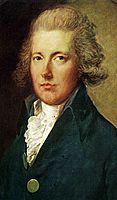First Pitt ministry facts for kids
Quick facts for kids First Pitt ministry |
|
|---|---|
 |
|
| 1783–1801 | |

Pitt by Thomas Gainsborough
|
|
| Date formed | 19 December 1783 |
| Date dissolved | 14 March 1801 |
| People and organisations | |
| Monarch | George III |
| Prime Minister | William Pitt the Younger |
| Total no. of members | 38 appointments |
| Member parties |
|
| Status in legislature |
|
| Opposition party |
|
| Opposition leaders |
|
| History | |
| Election(s) |
|
| Outgoing election | 1801 co-option |
| Legislature term(s) |
|
| Predecessor | Fox–North coalition |
| Successor | Addington ministry |
Imagine a time when Great Britain was led by a powerful government. This was the era of the first government led by William Pitt the Younger. He became the Prime Minister of the Kingdom of Great Britain in 1783. He was very young for such an important job, only 24 years old! His time as leader lasted for many years, until 1801.
During his time, big changes happened. In 1800, Great Britain and Ireland decided to join together. This was done through special laws called the Acts of Union. These laws created a new country: the United Kingdom of Great Britain and Ireland. The old British Parliament became the new UK Parliament.
Pitt continued to lead this new United Kingdom for about a month. However, he disagreed with King George III about an important issue. This issue was about allowing Catholics to have more rights, like holding public office. Because of this disagreement, Pitt decided to step down from his role as Prime Minister.
Who Was in Pitt's Government?
Pitt's government, also known as his ministry or cabinet, was made up of several important people. These individuals held key positions to help run the country. They were like the main team helping the Prime Minister make decisions.
Key Roles and Important People
- Prime Minister and Chancellor of the Exchequer: This was William Pitt the Younger himself. He was the main leader and also managed the country's money.
- Lord Chancellor: This person was the head of the justice system. For most of Pitt's time, this role was held by Lord Thurlow and later by Lord Loughborough.
- Lord President of the Council: This person led a group of advisors to the King. Many people held this role, including Lord Gower and Lord Chatham (who was Pitt's older brother).
- Lord Privy Seal: This role involved looking after the King's personal seal, which was used on important documents. The Duke of Rutland and Lord Westmorland were among those who held this position.
- Secretary of State for Foreign Affairs: This minister handled relations with other countries. The Duke of Leeds and Lord Grenville were key figures here.
- Secretary of State for War: This new role was created to manage military matters, especially during times of conflict. Henry Dundas was the first to hold this important position.
- Home Secretary: This minister was in charge of affairs within Great Britain, like law and order. Lord Sydney and The Duke of Portland served in this role.
- First Lord of the Admiralty: This person was in charge of the Royal Navy, which was very important for Britain's power. Lord Howe and Lord Spencer held this position.
- Lord Lieutenant of Ireland: This person was the King's representative in Ireland. Many different people held this role, including The Earl of Northington and The Marquess Cornwallis.
How Pitt's Government Changed Over Time
Over the years, some people in Pitt's government changed roles or left. New people joined the team. This is normal for any government that lasts a long time. For example, some ministers moved from one important job to another. New roles, like the Secretary of State for War, were also created as needed.
One big change happened in 1794. Several members of the Whig Party joined Pitt's government. This turned his government into a "coalition," meaning it was made up of members from different political groups working together. This happened because of the ongoing wars in Europe at the time.
Finally, in February 1801, some key ministers, including Lord Grenville and Lord Spencer, resigned. This happened just before Pitt himself stepped down.

